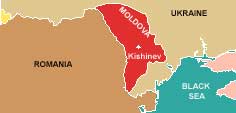Poison land
 In the farming regions of central Moldova, pesticides were applied at rates as high as 40 kg per ha from the '60s onwards and through the '80s. This rate of application is almost 20 times the world average. In one survey, researchers detected pesticide residues above accepted standards in 10-15 per cent of water samples. In one village, where an average of 22.73 kg/ha/year of active ingredients had been applied every year for a full decade from 1983 to 1992, soil samples revealed hexachlorane isomers, ddt and ddt metabolites (breakdown products of ddt, some which can be extremely toxic) 20 times in excess of accepted standards.
In the farming regions of central Moldova, pesticides were applied at rates as high as 40 kg per ha from the '60s onwards and through the '80s. This rate of application is almost 20 times the world average. In one survey, researchers detected pesticide residues above accepted standards in 10-15 per cent of water samples. In one village, where an average of 22.73 kg/ha/year of active ingredients had been applied every year for a full decade from 1983 to 1992, soil samples revealed hexachlorane isomers, ddt and ddt metabolites (breakdown products of ddt, some which can be extremely toxic) 20 times in excess of accepted standards.
Epidemiological studies further established that those exposed to pesticides had increased rates of infectious diseases. In one study, teenagers in villages, where pesticide application was the greatest, exhibited much higher rates of infection of the respiratory and digestive tracts than control populations living in areas of lower pesticide use:
• Respiratory infections: two-five times higher than control populations
• Digestive tract infections: three times higher than control populations
When pesticide-exposed communities were subjected to immunological tests, it was found that nearly one-third of the adults showed significant deviations in more than five immune system parameters, while more than two-thirds showed similar changes in two to five parameters.
To understand whether the increase in infections was related to the dose of exposure, Soviet scientists studied occupationally exposed farmers in particular. They found that these farmers had elevated rates of infectious diseases of the gastrointestinal, respiratory and urinary tracts and the female genital tract. The conclusion drawn was that "nearly all deviations observed (from the normal functioning of the immune system) are enhanced with longer exposure to pesticides'.
Related Content
- Order of the National Green Tribunal regarding elephant deaths in Bandhavgarh National Park attributed to Kodo poisoning, 10/01/2025
- Judgment of the National Green Tribunal regarding encroachment of land, Saket, Delhi, 20/12/2023
- Order of the National Green Tribunal regarding a salt factory polluting environment in village Dokha Dina, district Charkhi Dadri, Haryana, 21/09/2023
- Order of the National Green Tribunal regarding water body restoration, Kadaura, Jalaun district, Uttar Pradesh, 23/06/2020
- Pollution clamp on hotels, eateries
- 25 blackbucks 'poisoned' in Telangana
